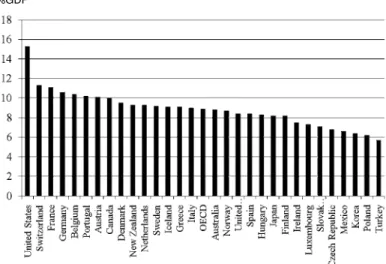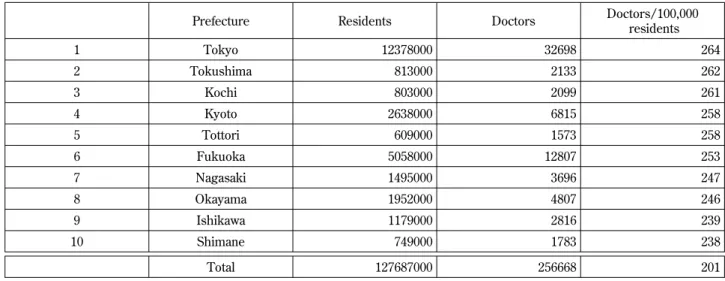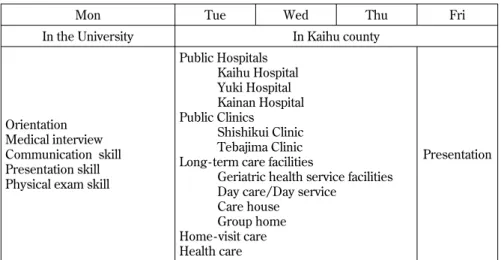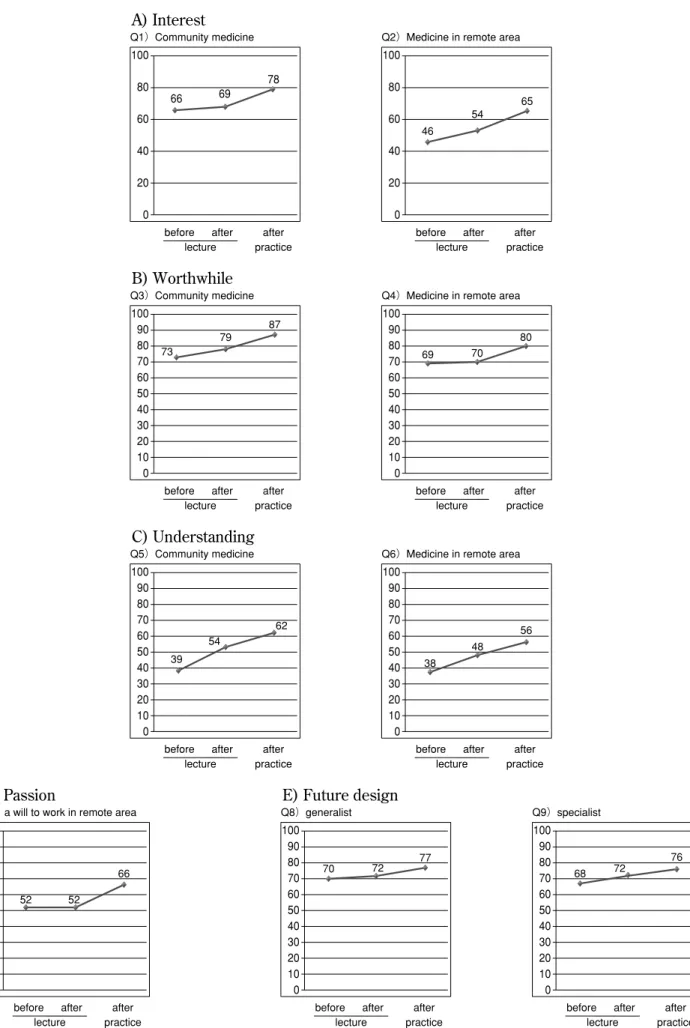0 50 100 150
2005 2010 2015 2020 2025 2030 <75y.o. >75y.o. year 128 127 125 123 119 (million) 9.1% 11.2% 13.1% 15.3% 18.2% 19.7% 115
AN AGING SOCIETY
We are in a severe aging society in Japan now. Es-timated populations in Japan are shown in Figure 1. The population of aged people is estimated to be in-creasing, and people aged 75 or over will occupy approximately 20% in 2030. Percentages of people who need a nursing care are increased by aging,
REVIEW
Evaluation of primary care practice in the University of
Tokushima
Kenji Tani
1, Takehiro Iwasaki
2, Shingo Kawaminami
3, Shino Yuasa
1, and
Atsuro Saijo
1 1Department of Community and Primary Care Medicine, Institute of Health Biosciences, the University of Tokushima Graduate School, 2
the University of Tokushima Faculty of Medicine, and3
the Post-graduate Education Center, Tokushima University Hospital, Tokushima, Japan
Abstract : The shortage of medical doctors is now a serious social problem in Japan. There are 2.1 physicians per 1000 residents in Japan, fewer than most other OECD countries. Tokushima Prefecture has the second highest population of medical doctors in Japan, but the shortage of medical doctors in rural areas was observed by an uneven distribution. Primary care practice was started in the education of clinical clerkship for 5thgrade medi-cal students of our university since July, 2008. They round a variety of hospitals, clinics and facilities for nursing-care during one week in Kaihu county where has a severe prob-lem in the shortage of medical doctors in Tokushima Prefecture. In order to research the efficacy of the primary care practice, we have administered a questionnaire for medical students before and after the lecture and practice, and the intensity was estimated in each student by using visual analogue scale. The results showed that the practice was more meaningful in increasing the intensity for interest and passion for community medicine and medicine in remote area than the lecture. Our data indicate that it is important to pre-pare more courses to learn primary care and general medicine in our clinical practice sys-tem to continue the interest and passion in community medicine. J. Med. Invest. 56 : 81-87, August, 2009
Keywords : primary care practice, general medicine, visual analogue scale, clinical clerkship
Received for publication May 29, 2009 ; accepted June 30, 2009. Address correspondence and reprint requests to Kenji Tani, M.D., Department of Community and Primary Care Medicine, In-stitute of Health Biosciences, the University of Tokushima Gradu-ate School, Kuramoto - cho, Tokushima 770 - 8503, Japan and Fax :
+81 - 88 - 633 - 9687. Figure 1 Estimated population in Japan
%GDP
Per 1000 residents
and approximately 50% of people aged 80 or over need a nursing care (Table 1). Since aged people
have various complicated diseases, they need gen-eralists who can care a variety of diseases. Organi-zation for Economic Co-operation and Develop-ment (OECD) Health data 2008 (1) showed that to-tal health spending accounted for 8.2% of Gross Do-mestic Product (GDP) in Japan in 2005, which is 0.7% lower than the OECD average, 8.9% (Figure 2). Thus, there are several complicated medical prob-lems in the future of Japan.
A SHORTAGE AND AN UNEVEN
DISTRI-BUTION OF MEDICAL DOCTORS
The shortage of medical doctors is now a serious social problem in Japan. Japan has fewer physicians per residents than most other OECD countries (Fig-ure 3). Japan had 2.1 physicians per 1000 residents in 2005, below the OECD average of 3.1. The Minis-try of Health and Labor has increased the number of medical students into the university since 2009 be-cause it recognized an absolute shortage of total number of medical doctors in Japan. An uneven dis-tribution has been known to be a serious problem because more doctors work in urban areas of all pre-fectures of Japan than in rural areas. The number of doctors per residents varys among 47 prefectures in Japan. Tokushima Prefecture has the second high-est population of medical doctors in Japan (Table 2). Table 1. Percentage of aged people who need a nursing care
Age (y.o.) Percentage 80!84 26.8
85! 50.7
Figure 2 Health expenditure as a share of Gross Domestic Product (GDP) Organization
The population of Tokushima Prefecture is approxi-mately 800,000, and most of them (68.7%) live in the east area, especially in Tokushima City (33.3%), the capital city. Therefore, though the number of doc-tors per residents varys among 8 cities and 16 towns in Tokushima Prefecture, it is more in east area of Tokushima Prefecture than in other areas. Espe-cially, Tokushima city has the highest population in Tokushima Prefecture, 440 doctors per 100,000 resi-dents.
PROBLEMS IN PREFECTURAL KAIHU
HOSPITAL
A shortage of medical doctors is more serious in the south and west areas of Tokushima Prefecture. For example, 18 medical doctors including 9 physi-cians worked at Tokushima Prefectural Kaihu Hospi-tal, which is placed in the south of Tokushima Pre-fecture, in Jun, 2004, but the number of them has decreased to 7 doctors which included only 2 physi-cians in Mar, 2009. Department of Community and
Primary Care Medicine was established in the Uni-versity of Tokushima Graduate School entrusted by Tokushima Prefecture on Oct, 2007. Missions of the Department are to research to relieve a break-down of community medicine in Tokushima Prefecture and to start the education system to experience the community medicine for medical students in the University of Tokushima Faculty of Medicine. At the same time, Community Medicine Research Center was established in Prefectural Kaihu Hospital as a research center of Department of Community and Primary Care Medicine. The Department has the following research projects to improve the environ-ment of community medicine and to train general-ists. 1) Research for development of education pro-gram about community medicine using clinical prac-tice, 2) Research for development for education pro-gram to train generalists, 3) Research for the effec-tive cooperation system among hospitals in local community, and 4) Research for the cooperation system to use medical resources effectively in com-munity medicine.
Table 2. The Number of doctors per residents
Prefecture Residents Doctors Doctors/100,000 residents 1 Tokyo 12378000 32698 264 2 Tokushima 813000 2133 262 3 Kochi 803000 2099 261 4 Kyoto 2638000 6815 258 5 Tottori 609000 1573 258 6 Fukuoka 5058000 12807 253 7 Nagasaki 1495000 3696 247 8 Okayama 1952000 4807 246 9 Ishikawa 1179000 2816 239 10 Shimane 749000 1783 238 Total 127687000 256668 201
Table 3. The number of doctors in Kaihu Hospital
Jun 2004 Apr 2006 Mar 2009
Physicians 9 2 2
Surgeons 3 3 2
Orthopedists 2 2 3
Brain surgeons 1 1 Part time
Gynecologists 2 1 Part time
Pediatricians 1 Part time
PRIMARY CARE PRACTICE
Community-based medical education provides medical students with opportunities to interact with people from a wide range of social and cultural back-grounds which are difficult to learn in large hospital (2-4). Before taking students into a community, there are several things that we should prepare. One of the most important points is to choose communi-ties and facilicommuni-ties that provide appropriate learning environments for the students depending on the ob-jectives of the activities. After the selection of com-munities, we contacted the local community leader and the community team, and performed the com-munity orientation which is important to inform them the purpose of student’s visit. Before the prac-tice, students also should know what to do in the community. Basic informations about the commu-nity such as environments, health service informa-tion and development of the community could be useful for the students to study there. Students should be aware that community members including nurses, public health nurses and care managers can be important teachers and active partners in the community activities.
Primary care practice was started in the education of clinical clerkship for 5thgrade medical students in
our university since Jul in 2008. They round a vari-ety of hospitals, clinics and facilities in Kaihu county during one week, and learn the importance of pri-mary care and patient care in the community medi-cine. A visiting home care and health education for residents, which is difficult to learn in the practice in the university, are included in the schedule (5, 6). Facilities which they round and the schedule are shown in Figure 4. After the orientation in the
university in which students practice about medical interview in community medicine and learn what they do in the community, they visit Kaihu county and stay for 4 days. Students present their schedule and impressions of the community medicine to staffs and residents, and discuss with them about various medical problems and concerns in the community including Kaihu county on the final day.
A QUESTIONNAIRE
We have administered a questionnaire for medical students before and after the lecture and practice, and the intensity was estimated in each student by using visual analogue scale (VAS). VAS is a simple method to obtain a self rating. It is a horizontal 100 mm VAS, with endpoints of 100 (strongest state) at the right and 0 (weakest state) at the left. Table 4
shows a list of questionnaire entries which consists of 10 questions. A slight increase was observed by the lecture in the intensity for interest in community medicine and medicine in remote area (+3 and +8, respectively) (Figure 5). On the other hand, the
Mon Tue Wed Thu Fri In the University In Kaihu county
Orientation Medical interview Communication skill Presentation skill Physical exam skill
Public Hospitals Kaihu Hospital Yuki Hospital Kainan Hospital Public Clinics Shishikui Clinic Tebajima Clinic Long - term care facilities
Geriatric health service facilities Day care/Day service
Care house Group home Home - visit care Health care
Presentation
Figure 4 Time schedule of the community practice in Kaihu county
Table 4. Questionnaire entries
Q1) Are you interested in community medicine? Q2) Are you interested in medicine in the remote area? Q3) Do you prove worthwhile to community medicine? Q4) Do you prove worthwhile to medicine in the remote area? Q5) Do you understand community medicine?
Q6) Do you understand medicine in the remote area? Q7) Do you want to work in medicine in the remote area? Q8) Do you want to become a generalist in the future? Q9) Do you want to become a specialist in the future?
Q1)Community medicine after after before practice lecture 66 69 78 0 20 40 60 80 100
Q2)Medicine in remote area
46 54 65 after after before practice lecture 0 20 40 60 80 100 73 79 87 Q3)Community medicine after after before practice lecture 0 20 40 60 80 10 30 50 70 90 100 69 70 80 Q4)Medicine in remote area
after after before practice lecture 0 20 40 60 80 10 30 50 70 90 100 39 54 62 Q5)Community medicine after after before practice lecture 0 20 40 60 80 10 30 50 70 90 100 38 48 56 Q6)Medicine in remote area
after after before practice lecture 0 20 40 60 80 10 30 50 70 90 100 52 52 66 Q7)a will to work in remote area
after after before practice lecture 0 20 40 60 80 10 30 50 70 90 100 70 72 77 Q8)generalist after after before practice lecture 0 20 40 60 80 10 30 50 70 90 100 68 72 76 Q9)specialist after after before practice lecture 0 20 40 60 80 10 30 50 70 90 100 A) Interest B) Worthwhile C) Understanding
D) Passion E) Future design
Figure 5 A questionnaire shown in Table 4 was administered for medical students before and after the lecture and the practice, and the intensity was estimated in each student by using visual analogue scale (VAS). The values are the means of 56 students.
practice increased the interest in both community medicine and medicine in remote area (+9 and +11, respectively) more than the lecture. The intensity for worthwhile in community medicine was similarly increased by the lecture and the practice (+6 and +8, respectively). On the other hand, the lecture did not affect the intensity for worthwhile in medicine in remote area (+1) but the practice greatly increased it (+10). In the intensity for understanding, the lec-ture increased the level of both community medicine and medicine in remote area (+15 and +10, tively) as well as the practice (+8 and +8, respec-tively). The intensity for passion to work in remote area was greatly increased by the practice but not by the lecture (+14 and 0, respectively). Both the lec-ture and practice slightly increased the intensity of a will to become a generalist. The intensity of a will to become specialist was also increased by the lecture and practice which may result from the effect of edu-cations except general medicine. These data indi-cated that the practice is more meaningful in in-creasing the intensity for interest and passion for community medicine and medicine in remote area than the lecture. Therefore, the repeated practice from the early grade may be important to continue the intensity. One of aims of our laboratory is to in-crease the number of medical students who are go-ing to work in community medicine in the future. It is important to prepare courses to learn general medicine in our clinical practice system to continue the interest in community medicine. However, to determine the role of the practice and lecture on education for community medicine, we need to evaluate an achievement level by using other ob-jective assessments such as written examination. Furthermore, it is important to research whether the practice results in increasing the actual number of doctors who work in the community medicine of Tokushima Prefecture.
Periods of primary care practice vary among uni-versities in Japan depending on the difference in education program of the universities. Primary care practice was performed in 5thor 6thgrade medical
students in approximately 80% of medical universi-ties, and periods of the practice in 43% of the uni-versities are within 7 days. These data show that systems of primary care practice in our university seems to be a nationwide scale and to be a standard. Although longer periods may result in more en-hancement of the practice, there are some problems to be cleared to prolong periods of the practice such as the number of staffs and other education program
in the university.
Educations to community medicine for early grade medical students as an early exposure are impor-tant. In our university, the social medicine prac-tice has been performed since several decades ago mainly for 3rdgrade medical students at various
kinds of welfare institution and nursing facilities. As an early exposure before medical students decide the future course, it may be important for them to give a chance to experience the community medi-cine developing the social medimedi-cine practice in our university.
COMMUNITY MEDICINE RESEARCH CLUB
IN TOKUSHIMA UNIVERSITY
Community medicine research club was formed by medical students in the University of Tokushima who have an interest in the community medicine on Oct 1, 2007. It included 13 members at the starting time, and has 42 members on Mar, 2009. They have visited various medical facilities to learn medicine and welfare, health care, nursing care, and team work with co-medicals. The activities of this club may have the following two meanings. First, this club gives medical students a chance to learn the im-portance of primary care and general practices in community medicine since the early grade though the lecture and practice about community medicine were performed for medical students for 3rdgrade
and over, 5thgrade and over, respectively. Second,
this club consisted of medical students from 1stgrade
to 6thgrade. Medical education in the curriculum is
usually performed for each grade. The members have a chance to communicate with those of other school years in the club.
REFERENCES
1. Economic Co-operation and Development
(OECD) Health data 2008. Kyodo News Serv-ice
2. Dornan T, Littlewood S, Margolis SA,
Scherpbier A, Spencer J, Ypinazar V : How can experience in clinical and community settings contribute to early medical education? A BEME systematic review. Med Teach 28 : 3-18, 2006
3. Jablonover RS, Blackman DJ, Bass EB,
Morrison G, Goroll AH : Evaluation of a na-tional curriculum reform effort for the medical
core clerkship. J Gen Intern Med 15 : 484-91, 2000
4. Griffith CH 3rd, Wilson JF : The loss of student
idealism in the 3rdyear clinical clearkships. Eval
Health Prof 24 : 61-71, 2001
5. Howe A : Twelve tips for community-based
medical education. Medical Teacher 24 : 9-12, 2002
6. Verby JE, Newell JP, Andresen SA, Sentko
WM : Changing the medical school curricu-lum to improve patient access to primary care. JAMA 266 : 110-113, 1991



